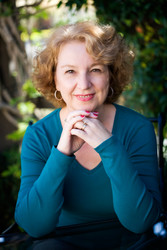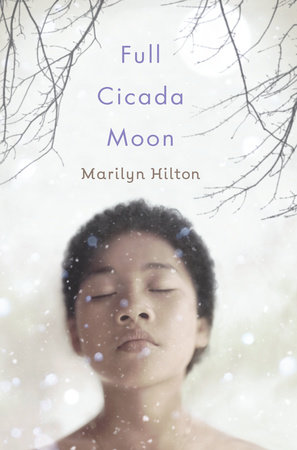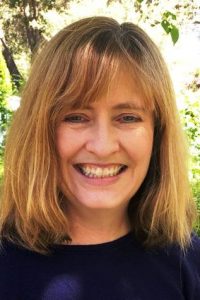interview by Kristi Wright

Marilyn Hilton, author of Full Cicada Moon (Dial Books, 2015)
KidLit Craft is pleased to welcome Marilyn Hilton to the blog!
San Francisco Bay Area-based author Marilyn Hilton writes lyrical middle grade novels in both prose and verse. As I read novel-in-verse, Full Cicada Moon, I was struck by how beautiful storytelling can be when an author use poetic techniques. And Marilyn’s first middle grade novel, Found Things, is a lovely example of prose with a poetic soul. We are delighted to share Marilyn’s reflections on her writing, including her insights into historical research and the revision process for a novel in verse.
Read a full craft review of Full Cicada Moon, if you haven’t yet.
Welcome to KidLit Craft, Marilyn. Let’s start at the beginning. What inspired you to write this story?
Marilyn Hilton: I wanted to tell a story that featured a protagonist who looked like my children, who are mixed-race. I wanted to tell a story from their perspective so that they could have a voice and a presence in literature.
Why did you write in verse rather than prose?
When I began writing this story, I felt it so urgently that I just began writing in verse form to get the story down. But the more I worked on the book, the more I realized that poetry was the perfect form for telling the story. And I loved writing that way! It was extremely freeing to include only what was necessary to say—and from the depths of the character. As you noted in your previous blog post, it’s a very intimate way of telling a story.
What came first? Mimi as a character or this particular historical setting?Definitely, Mimi came first. I could picture her and hear her voice. I knew her family and their history. I knew Mimi’s situation. Then I chose to place her in a small Vermont town in 1969, when it would have been likely that no other families would look like the Olivers, and at a time of great social change. Having grown up in New Hampshire and Massachusetts…er, many years ago…I knew that the fictional town of Hillsborough, Vermont, in 1969 would be portrayed realistically.
Given the pivotal time in history and the story’s specific setting, how did you go about tackling your research?
Researching for Full Cicada Moon was a wonderful experience, and I could write a whole book about it! But to make it short, I studied documentaries, books, and magazine and newspaper articles, I talked with people who’d lived then and had experiences similar to Mimi’s, I remembered my own experiences growing up in New England. I consulted pop music charts and fashion magazines, and scoured eBay for historical artifacts (such as the coin that Timothy gives to Mimi). Also, I had studied in Kyoto for a year after graduating from college (with a degree in Japanese), so I understood some nuance of language and culture. And I had consultants who reviewed the text as I wrote. For the time I was writing this book, I was virtually living in the 1960s.
 Did you write your poems sequentially or did you write them out of order? Can you talk a bit about that process?
Did you write your poems sequentially or did you write them out of order? Can you talk a bit about that process?
For the most part, I wrote the poems sequentially. I used a spreadsheet that tracked each poem’s title, what the poem was about, and what it had to accomplish (as if each poem were a mini-chapter). I followed that outline pretty closely. I also had columns for the date and time of day each poem took place, the phase of the moon, the weather, and notes. These columns were critical to the book, because I wanted the story to be as grounded in reality as possible. Finding the moon phases was easy, as it was on the Internet. Finding accurate weather conditions was harder, because 1969 weather records for central Vermont weren’t always available. But—so lucky for me—my great-grandmother had kept a diary nearly every year of her life and recorded the weather at the top of each page. She lived in central New Hampshire, which I figured was close enough to Hillsborough, Vermont, so I used a little poetic license by applying those conditions to Mimi’s story.
What was your revision process like?
After I handed in my first draft, my editor felt the story arc was pretty solid, but she asked me to fill in some holes, strengthen some threads with new poems, and do a bit of reorganization. Over the course of revisions, we decided to cut two poems that ultimately didn’t fit this book. The rest of the process was about tightening the content of poems and rewriting parts of poems for clarification.
Was this your first novel in verse? If so, what did you learn about craft from this writing experience?
Full Cicada Moon was my first novel in verse. I was nervous about starting it, but so often, practice is the best teacher. I wanted to tell this story, so I plunged in anyway, sensing I’d figure it out as I went along. And I did: I learned that each poem had to have its own arc, but some larger arcs took three or more poems to be completed. Sometimes the poems were interspersed throughout the story, and sometimes they appeared contiguously. I also played with line breaks and where to place lines and stanzas on the page.
How has writing a novel in verse informed your prose efforts?
When I first entered graduate school (for creative writing), I wanted to focus on writing prose. But I ended up taking lots of seminars in writing poetry as well. Poetry forced me to think about each word I chose, asked me to consider how my words could do double duty, and led me to create fresh images and metaphors that could sustain themselves throughout the poem. I’m so glad I had that training because it helped me apply those lessons to my prose.
For writers tackling a novel in verse, do you have any resources you recommend?
The best resources are the books that have been written in verse. Study how the poems are structured individually and then collectively as they tell the overall narrative. Look for poetic techniques—such as recurring metaphors or motifs—read the poems out loud for rhythm and internal or end rhyme, notice how the visual layout of a poem on the page expresses emotion. You might also take a poetry class or join a critique group that lets you experiment to find your poetic voice and style. Then, write your verse novel, trusting that you’ll figure out the unknowns as you go along.
What is next on the horizon for Marilyn Hilton’s fans?
I’ve been writing more poetry over the past year (and two of my poems will appear in the March 2017 issue of Glassworks Magazine). As for my novels, I’m finishing one middle-grade story, with a few other books waiting in line.
Kristi Wright (co-editor) writes picture books and middle grade novels. Her goal as a writer is to give children a sense of wonder, a hopefulness about humanity, and a belief in their future. She is represented by Kurestin Armada at Root Literary. She is an active volunteer for SCBWI and a 12 X 12 member. Find her at www.kristiwrightauthor.com and on Twitter @KristiWrite.

What a great interview! I was just looking for advice on how to approach a novel in verse, and ran across this. So helpful and interesting! Thank you Kristi and Marilyn